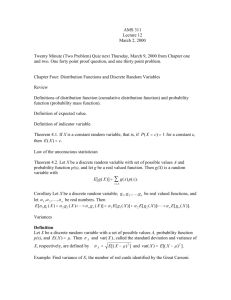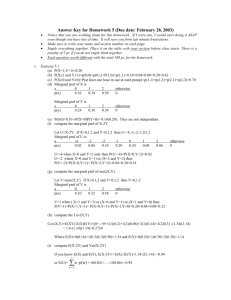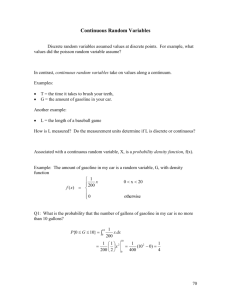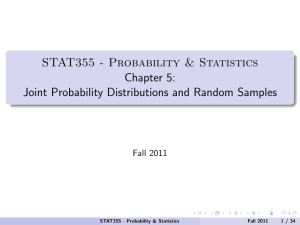Probability Homework: Random Variables & Distributions
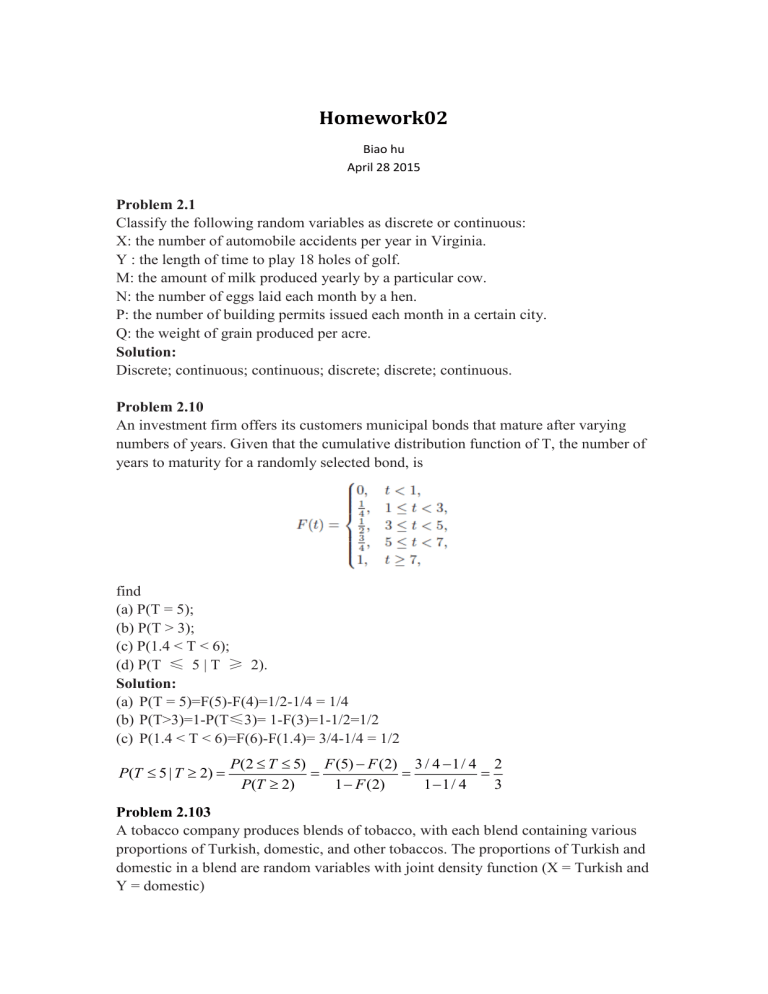
Homework02
Biao hu
April 28 2015
Problem 2.1
Classify the following random variables as discrete or continuous:
X: the number of automobile accidents per year in Virginia.
Y : the length of time to play 18 holes of golf.
M: the amount of milk produced yearly by a particular cow.
N: the number of eggs laid each month by a hen.
P: the number of building permits issued each month in a certain city.
Q: the weight of grain produced per acre.
Solution:
Discrete; continuous; continuous; discrete; discrete; continuous.
Problem 2.10
An investment firm offers its customers municipal bonds that mature after varying numbers of years. Given that the cumulative distribution function of T, the number of years to maturity for a randomly selected bond, is find
(a) P(T = 5);
(b) P(T > 3);
(c) P(1.4 < T < 6);
(d) P(T ≤ 5 | T ≥ 2).
Solution:
(a) P(T = 5)=F(5)-F(4)=1/2-1/4 = 1/4
(b) P(T>3)=1-P(T
≤
3)= 1-F(3)=1-1/2=1/2
(c) P(1.4 < T < 6)=F(6)-F(1.4)= 3/4-1/4 = 1/2
(
5 | T
2)
P (2
(
2)
5)
F (5)
1
F
F (2)
(2)
3 / 4 1/ 4
2
1 1/ 4 3
Problem 2.103
A tobacco company produces blends of tobacco, with each blend containing various proportions of Turkish, domestic, and other tobaccos. The proportions of Turkish and domestic in a blend are random variables with joint density function (X = Turkish and
Y = domestic)
24
0, xy , 0
,
elsewhere
1, x y 1
(a) Find the probability that in a given box the Turkish tobacco accounts for over half the blend.
(b) Find the marginal density function for the proportion of the domestic tobacco.
(c) Find the probability that the proportion of Turkish tobacco is less than 1/8 if it is known that the blend contains 3/4 domestic tobacco.
Solution: g(x)=24
0
1
x xydy
12 (1
x ) , for 0 1
(a) P(X
0.5)=12
1
0.5
x (1
)
2 x dx
1
0.5
(12 x
24 x
2
12
3 x dx
5
16
0.3125
(b) ( )
24
0
1
y xydx
12 (1
y ) , for 0 1
(c)
h y
y
24 xy
y )
2
(1
2
x y )
2
, for 0 x y
So,
1
8
| Y
3
)
4
0
1/8
2 x
1/ 16 dx
32
0
1/8
0.25
Problem 2.105
Two electronic components of a missile system work in harmony for the success of the total system.
Let X and Y denote the life in hours of the two components.
The joint density of X and Y is
ye
0,
y (1
x )
, ,
elsewhere
0
(a) Give the marginal density functions for both random variables.
(b) What is the probability that the lives of both components will exceed 2 hours?
Solution:
(a)
0
ye
y (1
x ) dy
1
1
x ye
y (1
x )
| +
0
1
1+ x
0
ye
y (1
x ) dy
1
x
2
( 1 ) e
y
x )
|
0
=
1
(1
x ) 2
,for x>0
(b)
( )
y e y
0
e y x y e
0 e
, e y f o r
0 y
(
2, Y
2)
0
ye
y (1
x ) dxdy
2
e e
yx
|
2
2
e
3 y dy =
1
3 e
3 y
|
2
1
3 e
6
Problem 2.106
A service facility operates with two service lines. On a randomly selected day, let X be the proportion of time that the first line is in use whereas Y is the proportion of time that the second line is in use.
Suppose that the joint probability density function for (X, Y ) is
3
( , )
2
0,
( x
2 y
2
) , 0
elsewhere
,
1
(a) Compute the probability that neither line is busy more than half the time.
(b) Find the probability that the first line is busy more than 75% of the time.
Solution:
(a) (
1/ 2, Y
1/ 2)
3 / 2
1/2 1/2
0 0
( x
2
)
1/2
3 / 2 (
0 x y
y
3
/ 3) |
1/2
0 dx
3 / 4
1/2
0
( x
2
1/12) dx
1/16
(b) P X
3 / 4)
3 / 2
1
3/ 4
( x
2
1/ 3) dx
53
128
Problem 2.111
The shelf life of a product is a random variable that is related to consumer acceptance.
It turns out that the shelf life Y in days of a certain type of bakery product has a density function
( )
1
2
0, e
y /5 , 0 y elsewhere
,
What fraction of the loaves of this product stocked today would you expect to be sellable 3 days from now?
Solution:
(
3)
1
2
3
e y / 2 e
3/ 2
0.2231
Problem 2.123
Assume the length X, in minutes, of a particular type of telephone conversation is a random variable with probability density function
( )
1
5
0 , e
x /5
, x
0, elsewhere
(a) Determine the mean length E(X) of this type of telephone conversation.
(b) Find the variance and standard deviation of X.
(c) Find E [(X + 5)
2
].
Solution:
(a)
0
x
5
x /5 e dx
5
(b) E x
2
( )
0
x
2 e
x /5 dx
50
5
So Var x
2
25 ,and
5
(c) E X
2
5) ]
E X
2
E X
2
E X
=
Problem 2.126
Show that Cov(aX, bY ) = ab Cov(X, Y ).
Solution:
Cov(aX, bY ) = E[(aX − a )(bY − b
X
)]
Y
= abE[(X −
)(Y −
X
)]
Y
= abCov(X, Y ).
Problem 2.129
In a support system in the U.S. space program, a single crucial component works only
85% of the time.In order to enhance the reliability of the system, it is decided that 3 components will be installed in parallel such that the system fails only if they all fail.
Assume the components act independently and that they are equivalent in the sense that all 3 of them have an 85% success rate. Consider the random variable X as the number of components out of 3 that fail.
(a) Write out a probability function for the random variable X.
(b) What is E(X) (i.e., the mean number of components out of 3 that fail)?
(c) What is Var(X)?
(d) What is the probability that the entire system is successful?
(e) What is the probability that the system fails?
(f) If the desire is to have the system be successful with probability 0.99, are three components sufficient? If not, how many are required?
Solution:
(a)
3
x 3
x
(0.15) (0.85) , for x
0,1, 2,3 x 0 1 2 3 f(x) 0.614125 0.325125 0.0573735 0.003375
(b) E(X) = 0.45.
(c) E(X
2 ) = 0.585, so V ar(X) = 0.585 − 0.45
2
= 0.3825.
(d)
P(X ≤ 2) = 1 − P(X = 3) = 1 − 0.003375 = 0.996625.
(e) 0.003375.
(f) Yes.
Problem 2.132
A convenience store has two separate locations where customers can be checked out as they leave.These locations each have two cash registers and two employees who check out customers. Let X be the number of cash registers being used at a particular time for location 1 and Y the number being used at the same time for location 2. The joint probability function is given by y x 0 1 2
0 0.12
0.04
0.04
1 0.08
0.19
0.05
2 0.06
0.12
0.30
(a) Give the marginal density of both X and Y as well as the probability distribution of X given Y = 2.
(b) Give E(X) and Var(X).
(c) Give E(X | Y = 2) and Var(X | Y = 2).
Solution:
(a) The ma rginal densities of X and Y are, respectively, x 0 1 2 g(x) 0.2 0.32 0.48 y 0 1 2 h(x) 0.26 0.35 0.39
The conditiona l density of X given Y = 2 is
X 0 1 2 f
|
2
( X | 2) (x) 4/39 5/39 30/39
(b) E(X) = (0)(0.2) + (1)(0.32) + (2)(0.48) = 1.28,
E(X
2
) = (0)
2
(0.2) + (1)
2
(0.32) + (2)
2
(0.48) = 2.24, and
Var(X) = 2.24 − 1.28
2
= 0.6016.
(c) E(X|Y = 2) = (1)5/39+(2)30/39 =65/39
E(X
2
|Y=2)=(1)
2
3/39+(2)
2
30/39=125/39
So Var(X)=125/39-(65/39) 2 =650/1521=50/117


